DISEASES OF THE EYES.
PERIODIC OPHTHALMIA (MOON-BLINDNESS),
Is a specific inflammation of most of the structures of
the eye. Relapses occur, lasting from 2 to 14 days. It
is dangerous, and is liable to be followed by a still more
dangerous disease—cataract. It is hereditary, but it may
be caused by rheumatic predisposition or blood contami
nation, a bite or blow, foreign substances under the lid,
overwork, especially the young, filthy and badly ventilated
stables, the eruption of the tushes, compression of the
roots of the molar teeth on the fifth pair of nerves, work
ing in coal-pits or other dark places, &c.
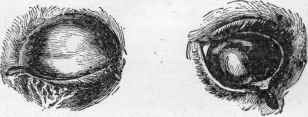
Fig. 28. First appearance of Fig. 29. Its termination.
Periodic Ophthalmia.
Symptoms.—First or inflammatory stage : Upper lid
droops; tears in superabundance ; lids, venous vessels,
and conjunctive membrane swollen; the globe dull and
sunken; circumference of cornea sometimes exhibits a
broad, nebulous circle; front chamber, at first usually
clear, becomes so obscured that the pupil is hardly dis
tinguishable; the pupil is contracted and resembles the
THE DISEASES OF THE EYES. 137
black eye of a garden bean; cornea, if not already, soon
becomes obscured; this obscures the pupil and iris.
Second stage : Gradual decline of inflammation and
tardy clearing of the cornea; iris altered in color and
lusterless; pupil contracted but less sensitive to light;
whitish or yellowish lymph effusions in chamber; these
and other favorable signs indicate recovery, but a relapse
usually occurs in a few days.
Remedy.—The periodic or specific form is incurable,
but it is relieved by purges, febrifuges, anodynes, bella
donna, or atrophine locally and internally.
For simple inflammation of the eye, occurring in all
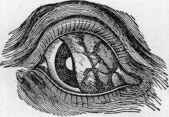
Fig. 30. The haw.
Fig. 31. Tenaculum.
animals : Remove any foreign body, securing the haw, if
necessary, with a tenaculum or stitch. Fomentation with
tepid water and decoction of poppy-heads abates irritation,
whether depending on foreign body or cold. Half dose
physic. Where inflammation severe, bleed from angular
vein. Belladonna and atrophine, locally and generally,
diminish irritation and prevent adhesion of iris. Steam
head when occurring with swelled lids, as in influenza at
tacks. Shade the eye.
138 THE DISEASES OF THE HORSE.
Silver nitrate and other astringent solutions for chronic
cases. For doses, see pages 13 to 29.
CATARACT
Is opacity of the lens or its capsule. Percivall says it
may also be the result of an effusion of an opaque fluid
between the two. The opacity may be the result of in
jury or disease.
Cataract is a common cause of either total or partial
blindness. It usually follows ophthalmia, but ophthalmia
may attack a cataractous eye. Cataracts are white, black,
green, yellow, brown, ash-colored, &c. At first they are
soft, but they acquire firmness by age. Some are called
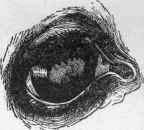
Fig. 32. Partial Cataract. Fig. 33. Complete Cataract.
bony cataracts. They vary in size from a pin’s point to
a pea.
Percivall speaks of both spontaneous and congenital
cataracts; D’Arboval of a fluid cataract, which, from its
whiteness, is called milky; Gibson of colts being foaled
with cataracts or pearls in their eyes.
Lenticular cataracts grow slowly—1, 2, or more years.
The other kinds may appear in a few days, or even hours,
and without any detectible inflammation or previous dis
ease. Capsular cataract is caused usually perhaps by ex
ternal injury. It is easily distinguished, and seems to be
absorbable,
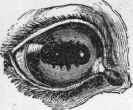
GLASS-EYE. ETC
139
In cataract with ophthalmia the iris frequently becomes
contracted and adheres to the capsule of the lens, thus
causing a permanently small pupil.
Remedy.—Extraction by operation. Belladonna or at-
rophine dilate the pupil for diagnosis (distinguishment),
alternated with physostygmine for obtaining free move
ment of iris. Phosphoreted oil, instilled into human eye,
if borne, leads to final absorption.
For doses, see pages 13 to 29.
Green Cataract (Glaucoma), is opacity of the vitre
ous humor (glass-like fluid) of the eye. Incurable. Cut
ting out (iridectomy) affords relief. Physostygmine dimin
ishes intraocular pressure (pressure within the eye).
AMAUROSIS OR GUTTA SERENA (GLASS-
EYE),
Is caused by paralysis of the optic nerve and retina.
There may be many causes of the paralysis, such as dis
eases of remote as well as contiguous parts, excessive bleed
ing, narcotic poisons, drinking too much cold water when
heated, pressure from a tumor, &c. There is no visible
defect in the eye—nothing abnormal except its great bril
liancy, from which it takes its name.
Symptoms—Head and ears erect, the latter set in
motion to learn the cause of any alarming noise; lofty
step; eyes insensible to light; pupils usually fixed and
widely dilated; sometimes there is a sluggish motion and
only moderate dilatation, &c.
Remedy—Except when depending on brain disorder
or debility, it is incurable. Blisters; setons around or
bit. Strychnine in traumatic (wound) cases ; also those
of nerve wasting, but unsuitable where there are brain
symptoms. For doses, see pages 13 to 29,
140
THE DISEASES OF THE HORSE.
WORM IN THE EYE
Is rare in this country, but is common in India. It is
like “an eel in a basin of water,” but is not always in
sight, for it may hide behind the iris. Dr. Gibbs (of
India) has seen two worms in an eye at once. He has
also seen a second worm appear months after the removal
of the first. They are peculiar to cold weather and wet
seasons. Similar worms are found in the stomach and
intestines. They probably reach the eyes through the
blood. If no operation is performed, blindness may result.
But the worm may die and become absorbed.
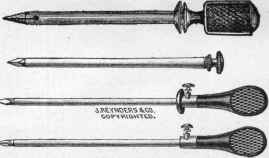
Fig. 34. Trocars. An operation for Worm in the Eye would require a
special trocar.
The only remedy of course is to trocar or lance the eye,
an operation the skillful surgeon only can perform.
“WATERY EYES”
Are uncommon. The real cause of the overflow of tears
is obstruction of the tear canals, which run from the eyes
to the nostrils; but superabundant secretion of tears may
sometimes occur perhaps. It seems to be analogous to
stricture of the urethra in man. The canal is not uni-
THE DISEASES OF THE EYES.
141
form in size, diminishing at first, then enlarging, besides
which it is tortuous near its center.
Remedy.—Syringe from above, and below also, if nec
essary. If this fails, probe.
ENLARGEMENT OF THE LACHRYMAL
CARUNCLE.
The lachrymal caruncle is a small, reddish, follicular
body, situate at the inner angle of the eye. It is harm
less when small. Its removal is sometimes followed by
more or less inflammation and sometimes “ watery eyes.”
Percivall removed one as large as a marble by ligature,
tightening the cord on the second, fourth, and sixth days,
when the excrescence (for such it had become) fell off.
The operation caused great local disturbance, but it did
not show itself till twelve days afterward. Bathing the
eye, purging, and salivation with calomel followed. Re
covered.
TUMORS AND FUNGUS OF THE ORBIT.
Percivall operated successfully on an exostosis (bony
tumor) of the orbital arch, which had grown to the size
of a horse-chestnut. It half eclipsed and pressed upon
the eye. Doctor Perry treated a 3d ays-old foal that was
said “ to have no eyes.” He found a fungus within the
orbit of the near side about the size of a pistol-ball, with
out any organic structure. That of the other orbit was
of similar appearance, but somewhat larger, with the ad
dition of the haw.
All tumors interfering with the sight or the movements
of the eye should be removed.
But first, if you want to come back to this web site again, just add it to your bookmarks or favorites now! Then you'll find it easy!
Also, please consider sharing our helpful website with your online friends.
BELOW ARE OUR OTHER HEALTH WEB SITES: |
Copyright © 2000-present Donald Urquhart. All Rights Reserved. All universal rights reserved. Designated trademarks and brands are the property of their respective owners. Use of this Web site constitutes acceptance of our legal disclaimer. | Contact Us | Privacy Policy | About Us |